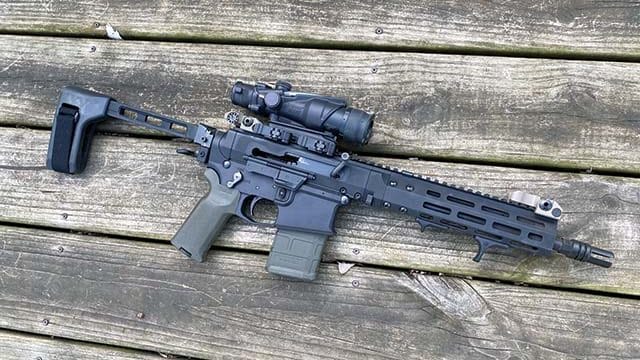Story & Photography by Josh Wayner
Perhaps one of the most overlooked rifle designs to come out of the Cold War era was the ArmaLite AR-18, a gun that did some impressive things for its time. The design of the AR-18 was not exactly revolutionary or exceptionally innovative considering the other, more radical models put forth by the company, such as the well-known AR-15. Today, Brownells has graduated from a premier supplier of parts and gunsmithing tools to offering and even resurrecting guns like the AR-18, perfected as the BRN-180™ and BRN-180S™.
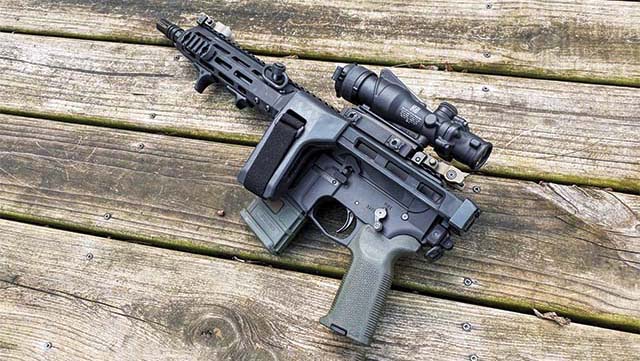
ArmaLite Does a “180”
The “AR” in AR-15 does not stand for “Assault Rifle,” as the media would have you believe; instead it is a simple initialization of “ArmaLite Rifle.” The company introduced the action developed in large part by Eugene Stoner, which was a space-age aluminum set of upper and lower receivers with the gas system routed directly into the action to cause it to cycle. This was something of a revolutionary concept, but it was of course met with a healthy degree of criticism when it was put to the test.
The AR-15 first saw action in the early stages of the Vietnam War, and NATO had recently decided to standardize the 7.62x51mm cartridge. The AR platform chambered for 7.62x51mm was dubbed the AR-10, but it was not fully developed in time for the NATO tests that would eventually see the American adoption of the M14 rifle, which itself was a variant of the M1 Garand used in World War II and Korea.

The initial reviews from combat use of the AR-15, which at the time used a revolutionary small-bore 5.56x45mm cartridge, were positive, and the fully automatic weapons were then dubbed the M16, with later improvements being designated as the M16A1 and XM177/CAR-15. Problems, some catastrophic, were immediately apparent despite the good start. Representatives from Colt, the licensed manufacturer of the rifle, were sent to the war zone to diagnose the problems with the rifles, reported by American soldiers.
The problems with the M16 proved deadly to many American troops, who were up against mature weapons such as the AKM and SKS in close combat. The rifles were just not all that great for use in a damp, muddy environment, and it seemed that the world’s largest industrial power had failed to deliver a basic rifle to fight the communists head-to-head. The change in powder used in the cartridges led to the majority of the issues experienced by U.S. troops.
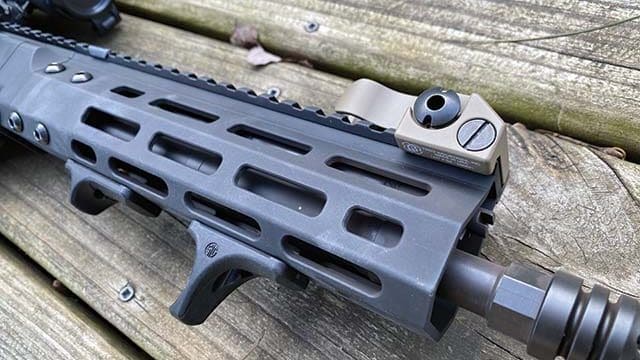
By the time that the problems with the M16 were resolved, the faith in the rifle had already been shattered. It would live on to become the darling of the shooting public, but only after 50 years of cautious testing and several more wars and conflicts.
In the late 1960s, ArmaLite began to look at some new designs and manufacturing techniques that would perhaps gain it some greater traction in the marketplace. Unfortunately, this was not the case whatsoever, and there were only around 20,000 AR-18 rifles made over its short production life. The design was considered to be rudimentary, as it used welded and stamped receiver components and had a generally crude appearance when compared to the more elegant AR-15.
The ArmaLite company had, in just around a decade, gone from making what was considered a space-age rifle to developing technology that had already been tried and tested, old news in other words. The AR-18 was put into only a small handful of trials, and it offered no real advantages to the maturing M16A1 or the Soviet AKM and their respective suites of arms. As a result, the design was shelved, and manufacturing ceased in 1985. It was only produced for 16 years.
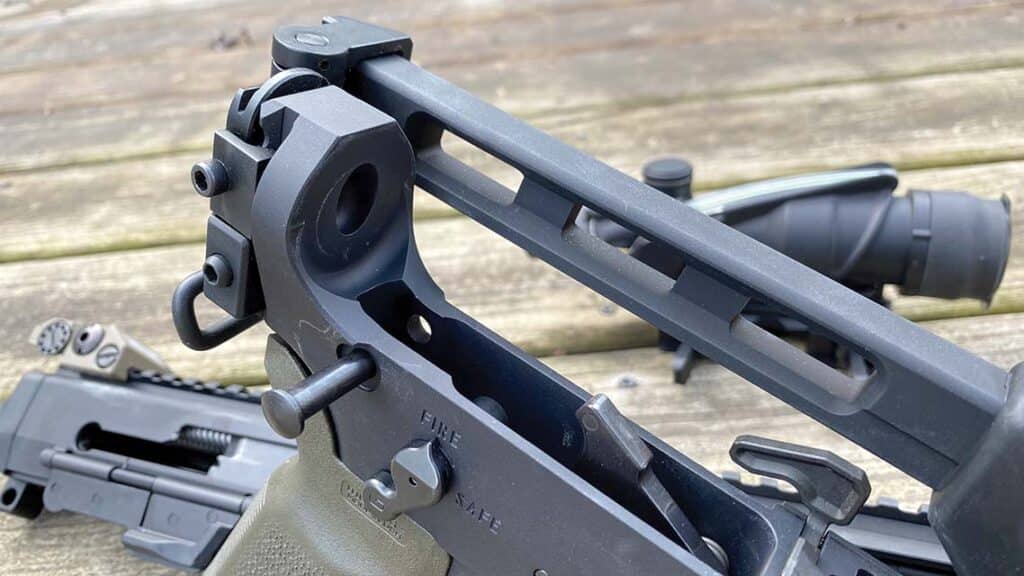
The Widowmaker
The AR-18 would have likely vanished into the footnotes of rifle history had it not been for its significant and bloody use in The Troubles in Northern Ireland. The Irish, long held under the boot of the English since the reign of King Henry VIII, attempted to rectify hundreds of years of occupation through armed rebellion and to oust the English from their lands. There had been many attempts at this, but all had failed to give the Irish the result they wanted.
The AR-18 (AR-180) became the star rifle of the Troubles, where it was seen as something of an equalizer in combat. The Provisional Irish Republican Army (PIRA) was instrumental in making the AR-18 into the symbol of Irish independence and the will of their people to reclaim their ancestral lands. Indeed, the implications of the rifle were far reaching, culminating the ultimatum campaign called “ArmaLite and Ballot Box” strategy. The prevalence of the AR-18 in the conflict made this a serious issue to the British, who were basically presented with the choice of allowing referendum in Ireland or facing violence using the ArmaLites, among other weapons.
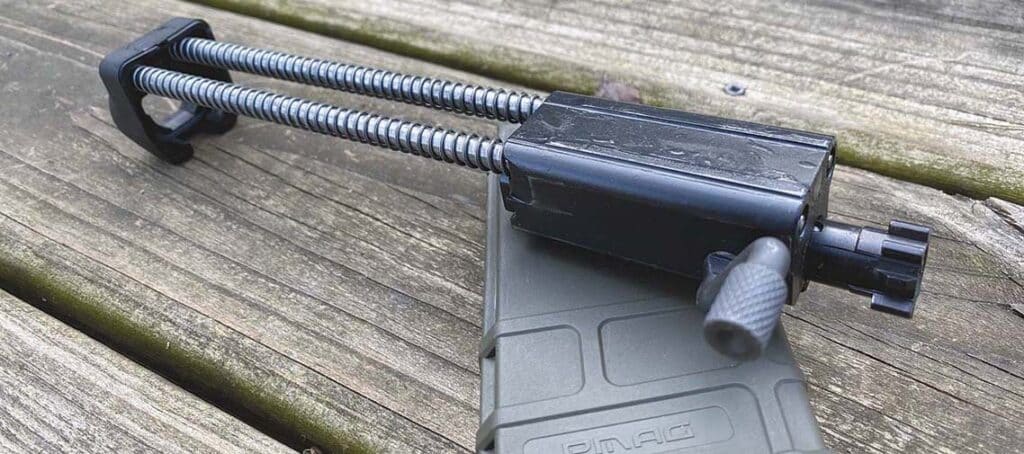
The weapon became so highly valued and famous among the Irish that it was the subject of folk songs and murals. The IRA soldiers using the rifle favored it greatly due to its compact folding stock, light weight, simplicity, reliability and excellent medium- to long-range accuracy. It eventually became so feared by the British soldiers and loved by the IRA that it was nicknamed the “Widowmaker.” Indeed, it was a frightful rifle to face, with the British forces unable to answer it in terms of portability and lethality in the areas the IRA chose to fight. Anyone could have an AR-18 about his or her person and use it effectively, which of course was a terrifying notion for those considered to be occupiers.
After the decades of fighting ended, not much had truly been achieved, but thousands were dead or wounded as a result. The AR-18 continues to be an element present in Irish culture, but its influence today is purely symbolic. The semiautomatic rifles can be found today on the U.S. civilian market for around $1,500 USD, but they are not in high demand except by ArmaLite collectors. Many modern rifles are loosely based on the AR-18’s pistol operating system, but the success of those designs has varied depending on nation of origin and number produced.
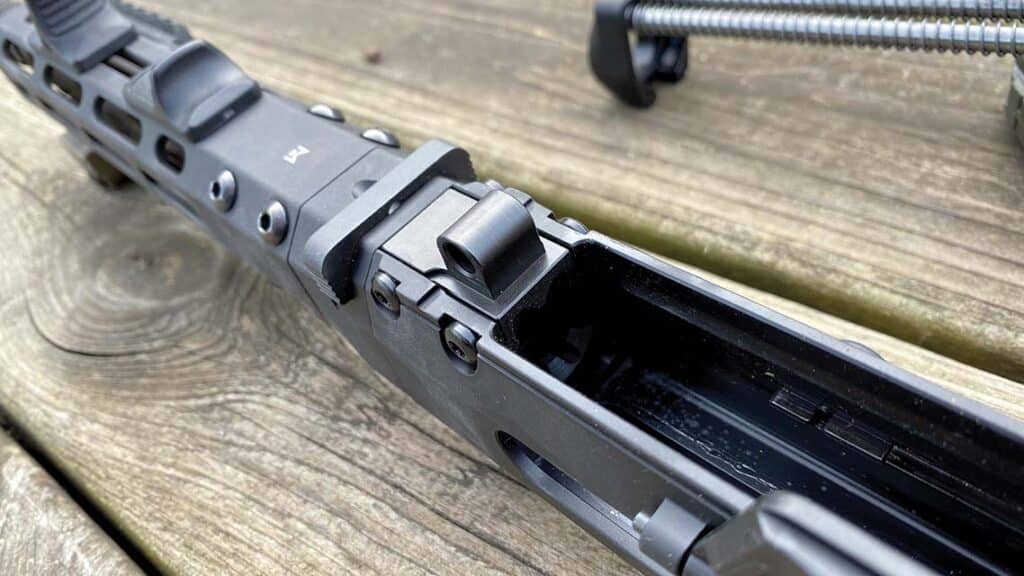
Enter Brownells
The author spent some time talking to Paul Levy, director of Product Management at Brownells. The company released a surprising product at the 2019 SHOT Show. They were starting to produce a version of the AR-18, called the BRN-180. The interest was immediate, but one would wonder why Brownells, one of the largest retailers of gun parts and accessories in the world, began creating an obscure gun like the AR-18?
“It started with just being a fan of the AR-18. We had worked with some various companies getting the BRN-10 to market, and we then started working on a translation of the AR-18. I sent that over to Dean Sylvester at Primary Weapon Systems (PWS) and Paul Noonan at FM Products for engineering. I wanted to keep the design close to the original. After a few revisions, we had a free-floating handguard, rails and M-LOK compatibility.”
Brownells came to market swinging, and it created some waves. While the primary thing that made it attractive was the fact that it could utilize a folding stock, as there is no buffer tube, the other advantages became rapidly apparent, and what Brownells released was nothing short of extraordinary. What they ended up with was an extremely simple and ruggedized receiver unit that has the potential to be more reliable and go longer between maintenance sessions and cleanings than the AR-15. The best part is, if you have an AR lower, it is a drop-in proposition.
“The heart of the design is based on the AR-18. The gas system and the recoil assembly are close copies. The carrier travel distance had to be the same as the AR-15 in order to make it compatible with today’s popular AR lower receivers. The AR-18 had a longer carrier travel distance. It wouldn’t have really worked if we did a 1:1 recreation. There are no interchangeable parts with the AR-18. The BRN-180 is basically an improved version instead of a direct copy. We tried not to reinvent the wheel, and our goal was to make a rugged and reliable rifle that was as accurate and reliable than the original. Instead of stamping, we use aluminum extrusions. This is stronger.”

Just how good and reliable is this design? The internal components are deceptively simple, consisting of a bolt group that travels along two guide rods. The action has dual springs and simply pulls out the rear of the receiver. Cleaning is very simple due to the fact that the action is just a rectangular box. Wiping it out with a rag is just about all it takes, unlike the AR-15 action with its various nooks and crannies.
The internal tolerances are a bit looser than the AR-15 and will remind the user of a high-quality AK-47. The action itself is remarkably slick and smooth. It is so easy to work the action that it can be pulled back and into battery with just a finger. When lubed up, it feels as smooth as a custom polished action.
The samples used for this article were assembled with the new Brownells BRN-180 lowers, which are just like AR-15 lowers but have a closed-in area where the buffer tube would have gone, as well as the BRN-180S 10.5-inch upper. In place of the tube there is a Picatinny rail segment to allow the mounting of stocks or folding braces. This is a huge plus and really lends utility to the design. A note on the lowers is that this version in the article is a more conventional AR style, but there is a version that is coming soon that will mimic the lines of the AR-18, including the reverse-slanted magazine well. The lower assembles in almost the same way as a standard AR lower, but there are some differences near the rear pin. The retaining pins and springs are retained by the grip, same as the safety pin and spring.
Levy continued the conversation, this time looking at the capabilities of the design.
“We never really made the BRN-180 to be a 1 MOA gun, but you can certainly expect 1.5 to 2 MOA. We came at it with the purpose to create a rugged and reliable rifle, and that’s what we delivered. If you want to shoot prairie dogs at 500 yards, this probably isn’t your gun, but if you want to get down in the dirt, it is every bit as good as the original AR-18.”
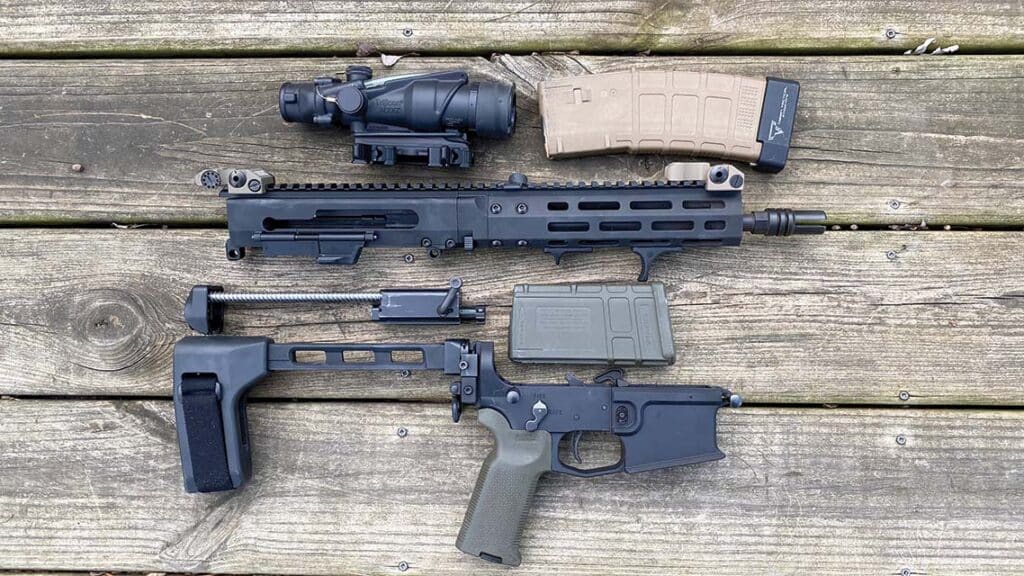
The BRN-180S Design
Just how accurate and reliable is the design? Well, there is no real bad news here. The BRN-180S is fully capable of outperforming many competing designs and is exceedingly accurate and durable. In the testing performed by the author, it was proven to him that Levy was in fact being modest. The build completed by the author featured only high-end components. The internals of the lower were all from Geissele Automatics, including the trigger, safety with dogleg levers and all pins and springs. The folding brace is the highest quality available from SB Tactical, and it features an aluminum body. This brace mounts to the rail on the rear of the receiver. The build was topped with a set of folding Troy folding iron sights and a Trijicon ACOG 4×32 TA31 in a Midwest Industries QD mount. All these components noted in the article, with a couple minor cosmetic variances, are available directly from Brownells. The build was tested … brutally.
The first procedure was to zero the build at 25m with both the irons and the ACOG. Zeroing with the irons took seconds using 62-grain FMJ Frontier 5.56mm ammo from Hornady. This is good quality ammo, and it shoots very well in the short barrel used for this build. Three-round groups at this distance were ¼-inch—a great sign! The ACOG was then zeroed, and the BRN-180S was put to work at distances out to 200m.
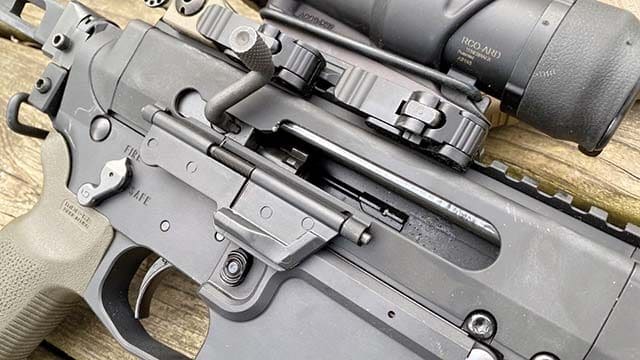
The first thing to note about this build is just how smooth shooting with it is. The recoil impulse is far different than that of an AR-15, likely due to the low mass of the cycling parts and the slickness of the action. It was just flat out pleasant, and recovery time from shot to shot was amazingly fast. This action has to be experienced to be believed, and the author was floored by what Brownells managed to deliver at such a modest price, but more on that later.
When it came to accuracy further out, the short barrel was not deterred. It was easily as accurate as any combat-style AR out there and even better than most. Average accuracy with the 62gr FMJ was 1.5 inches at 100m. The real accuracy test came with Black Hills Ammunition’s 77-grain OTM load, a cartridge that is the civilian variant of the legendary MK262 Mod 1. If a gun has trouble shooting, this load is the one you want to use to get it going as it should. It is not a weak-sauce load, and it offers full pressure and velocity for these heavy-for-caliber bullets. The 77gr OTM shot to 1 inch at 100m and did extraordinarily well at 200m. It shot an average 2.1 MOA group for five shots at that range using the ACOG, which is extremely impressive and a testament to the high-quality product Brownells was able to bring to market.
When it came to reliability, the author loaded up 35-round mags featuring Taran Tactical Innovations extensions and went to town at short range. The build was subjected to 750 rounds immediately. This ammo was a mix of 55-grain SIG SAUER and Hornady FMJ loads. A total of 2,350 rounds were fired in one session with absolutely zero malfunctions or failures to feed or eject. It was also not cleaned for the entire duration of the test. The longest string of fire was 500 rounds in one hour-long session, which is a lot for any gun.
After all that, the build was checked for zero, and there was no significant deviation or even a shift of impact after all that racket. The BRN-180S was easily banging 10-inch plates at 200m, and it showed no signs of stopping. The rigid receiver and stiff barrel made it a real winner for this type of use. As fast as handling goes, it was easy to master if you’ve ever shot an AK rifle. It is in no way similar to the AR except in the safety and magazine release. Switching to a side-charging handle is an adjustment, but it is second nature once you have an hour or two on it.
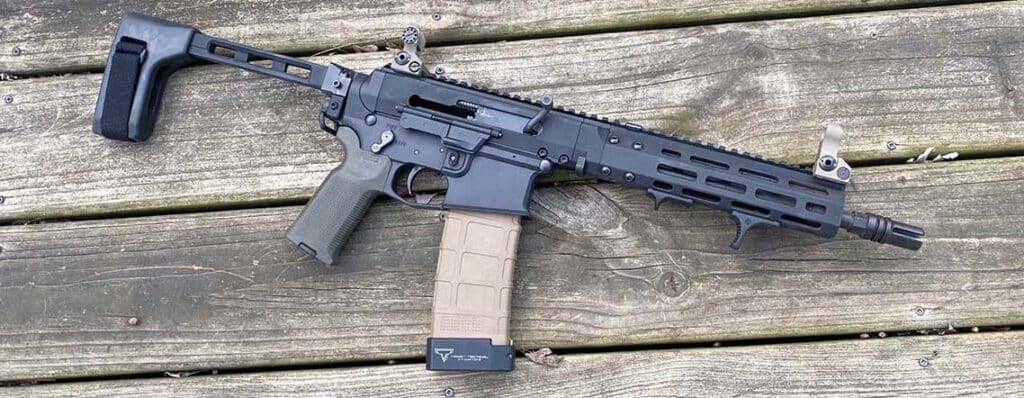
The Modern AR-180 or Just a Gimmick?
“I’m happy with the reception, and we’re excited to continue developing the design. Hopefully we’ll see some new variants and additional products to the BRN-180 line in the near future.”
Levy sees a bright future for the relatively new design. It is something of a novelty to many shooters, but the BRN-180/180S have some major and distinct advantages over existing systems, and the possibilities are endless, so long as they gain traction in the market.
The idea that this is just a gimmick and a one-off is shortsighted. The companies involved with Brownells in getting this on the market did so in a way that others couldn’t. Many competing and now defunct designs failed to make it to success on the open market, including the original AR-18. Had it not been for the guerrilla warfare use of the weapon, it would have likely never been remembered. The design itself was, for the most part, better than the AR-15, but it never won the fame of its brother. The product released as the BRN-180S is the culmination of the AR-15’s modularity and the simplicity of the AR-18. It is a nearly perfect blend of both designs, and Brownells executed it precisely.
There have been many attempts to pull off something like this, but none have made it. Some rifles based off the elements of the AR-18, such as the Bushmaster ACR, were great ideas but failed to succeed on the commercial and military markets. Rifles like the FN SCAR could be thought of as something of a variant of the AR-18, with the same going for the British SA80 and HK G36. These rifles have all been met with a degree of criticism over time and have had significant teething problems. What Brownells did with the release of the BRN-180S, delivering a 100% reliable and functional weapon platform with no real downsides is exceptional. Many nations of the world have failed to develop weapons as reliable and accurate for their primary service arms.
What does this mean for Brownells and the future of their engineering collaborations? Well, the fact is that they came out of nowhere with an apparently mature system that is a compliment to the most popular rifle type in the country, something nobody else has really succeeded in doing correctly. The only problem is getting word out about the BRN-180S, as most people assume it to be a novelty. Even so, this is a true novelty in that it works 100% right out of the box, which is more than some prominent companies can say about the launch of a major product line. The bottom line is that the BRN-180S is a seriously good product that demands a close look for any shooter looking for a compact, reliable and easy-to-maintain rifle that has all the advantages of the AR-15 but none of its shortcomings.
| This article first appeared in Small Arms Review V24N7 (Aug/Sep 2020) |



